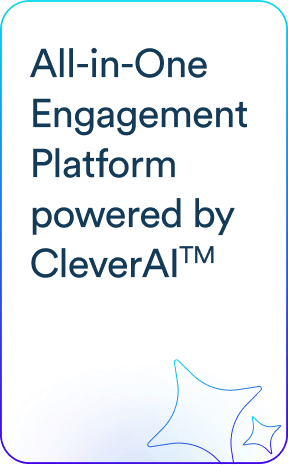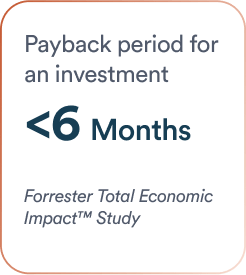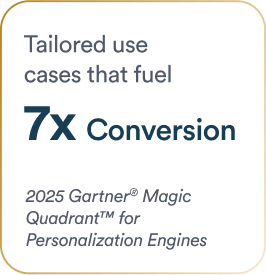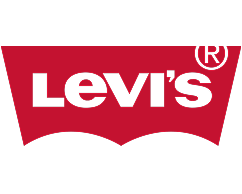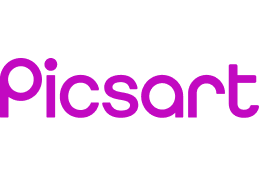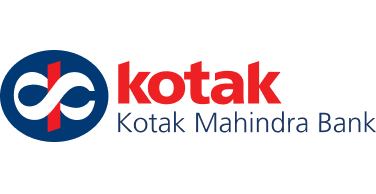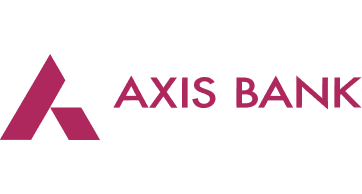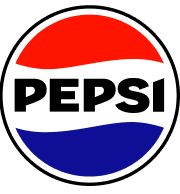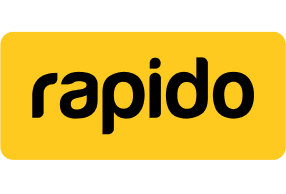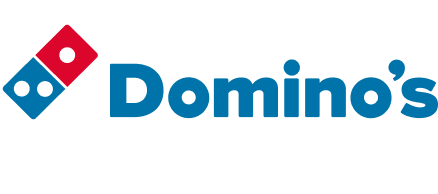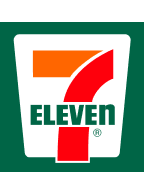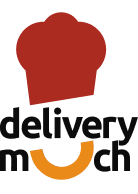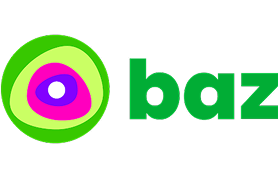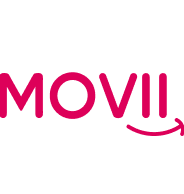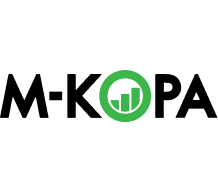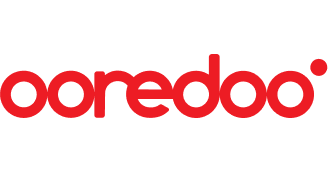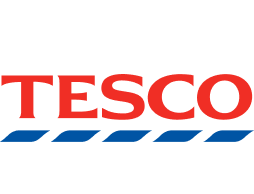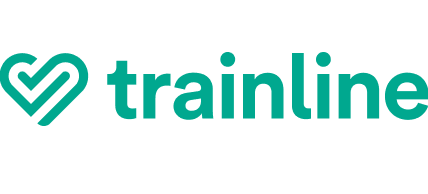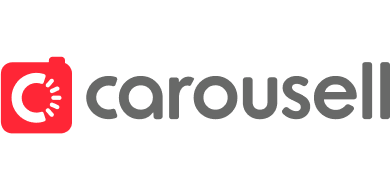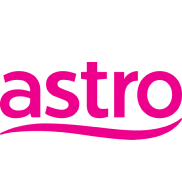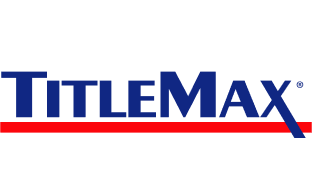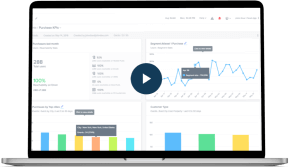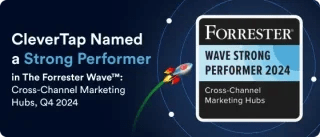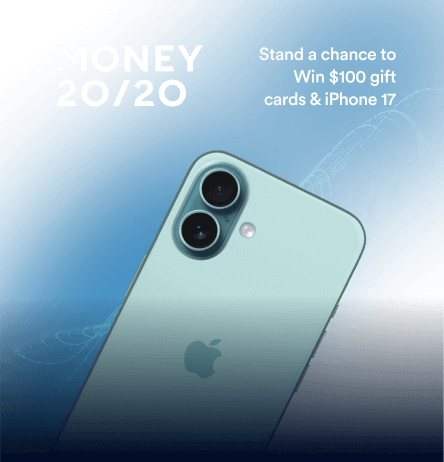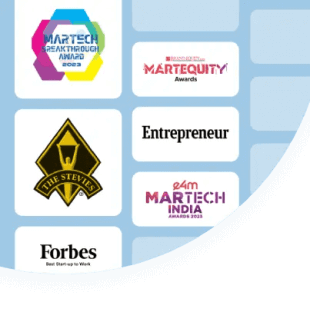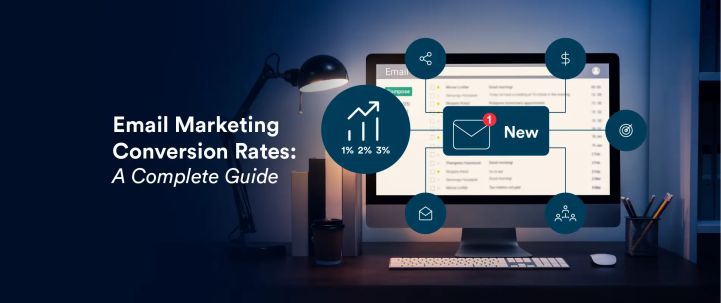Email marketing continues to deliver the highest ROI of any digital channel. According to Litmus, for every $1 invested in email campaigns, marketers receive $36 in return. The email marketing conversion rate is what drives the revenue: anyone can do a blast send, but creating high-converting and compelling emails is a skill.
This guide explores everything you need to know about email conversion rates – from calculation methodologies to advanced strategies and AI-powered optimization techniques. You’ll learn how to boost your conversion rates effectively, along with actionable tips to maximize every email’s impact.
What is Email Marketing Conversion Rate?
Email marketing conversion rate measures the percentage of email recipients who complete a desired action after opening your email. While it’s often associated with purchases, email conversion can include a range of actions along the customer journey—like signing up for a webinar, downloading a resource, or upgrading a plan.
Examples of Email Conversions:
- For an e-commerce store, a conversion might be a completed purchase from a product promotion email.
- For a banking or financial services provider, a conversion might be opening a new account, applying for a loan, or scheduling a consultation with a financial advisor.
In all these cases, the core idea is the same: you want your email to drive your audience to take meaningful action. The conversion rate reflects how effective your email was at doing just that.
Measuring conversion rates from email marketing helps marketers understand campaign effectiveness and refine strategies to drive higher engagement and revenue.
Average Email Marketing Conversion Rate Benchmarks
Some studies report the average email conversion rate to be between 2% and 5%.
However, what qualifies as a “good” email conversion rate is highly dependent on specific factors such as your industry, target audience, and the nature of your email campaigns. For instance, industries like fashion and beauty may experience different average conversion rates compared to sectors like finance or technology.
Therefore, while industry averages can offer a point of reference, the most effective strategy for achieving sustained success in email marketing is to focus on improving your own campaign performance over time.
The email open rates vary by industry as well. Based on CleverTap’s study of e-commerce, fintech, foodtech, travel, and streaming apps in 2023, here is the average open rate for emails across these industries:
| Industry | Email Open Rate |
| E-commerce | 27% |
| Fintech | 34% |
| Food Tech | 25% |
| Travel | 35.17% |
| Streaming | 19.63% |
But, while email open rates help you assess interest, conversion rates help you measure real impact by showing how many recipients took meaningful action.
In a 2023 Statista survey conducted among marketers across nine countries, conversion rate emerged as the most favored metric for evaluating the success of email marketing campaigns, aside from the open rate.
Specifically, 26.5% of professionals prioritized the conversion rate as their key performance indicator. Following closely, click-through rate (CTR)—which measures the proportion of recipients who clicked on one or more links within an email—was selected by nearly 24% of marketers as their preferred metric for assessing campaign effectiveness.
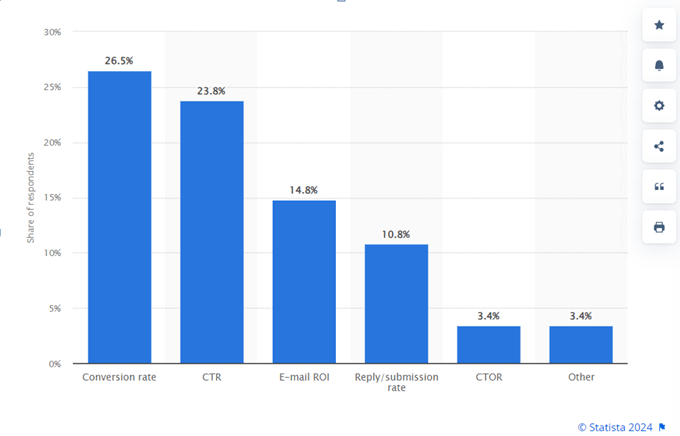
Source: Statista
Learn more about email marketing metrics to get a full picture of your email campaigns’ effectiveness.
How to Calculate Email Marketing Conversion Rate
The standard formula for calculating email conversion rate is:
(Number of conversions ÷ Number of delivered emails) × 100
To calculate the email conversion rate:
- Track total emails delivered: Remove bounces from the total emails sent.
- Monitor conversions: Identify the number of recipients who completed the desired action.
- Apply the formula: Divide conversions by emails delivered and multiply by 100 to get the percentage.
For example, if you send 10,000 emails that are successfully delivered, and 300 recipients take the intended action, such as completing a purchase or renewing a subscription, your conversion rate is 3%.
A high conversion rate typically indicates that the content, timing, design, and audience targeting of your email are aligned with user intent. On the other hand, a low conversion rate may signal issues in your messaging, segmentation, or the value proposition being offered.
Factors Affecting Email Marketing Conversion Rate
Email marketing conversion rates are influenced by a combination of audience targeting, content strategy, technical optimization, and behavioral triggers. To maximize effectiveness, you must fine-tune various elements that impact engagement and actions taken by recipients.
Below are five key factors that shape email marketing conversions.
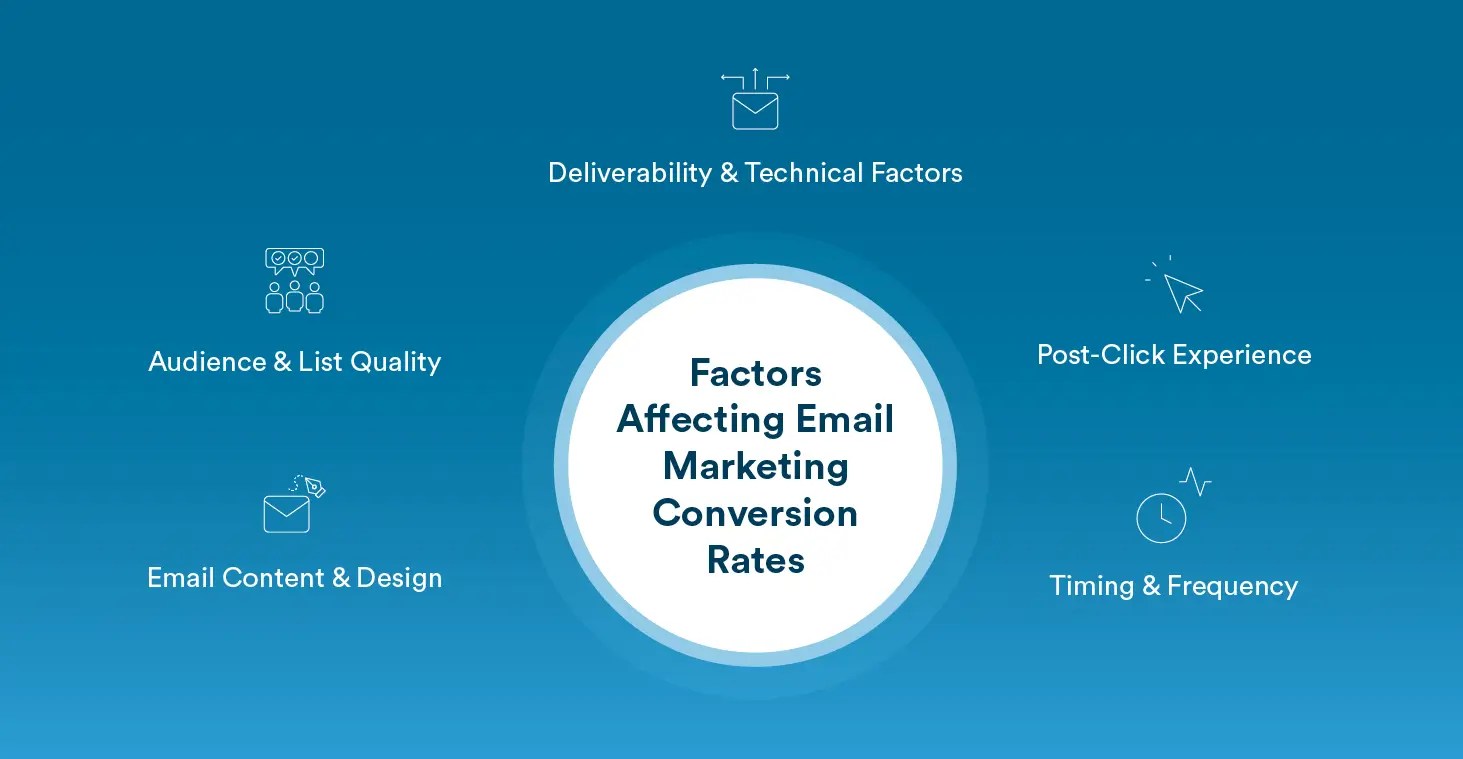
1. Audience & List Quality
The foundation of successful email marketing lies in having a well-maintained and highly targeted email list. This can be achieved via:
- List Hygiene: Removing inactive subscribers and invalid emails prevents bounces and boosts deliverability.
- Segmentation & Targeting: Sending relevant emails to the right audience improves engagement.
2. Email Content & Design
Compelling content and visually appealing design play a crucial role in driving conversions. This includes all aspects of an email, including:
- Subject Line & Preheader
- Email Copy & Value Proposition
- Call-to-Action (CTA)
- Visual Appeal
- Personalized Dynamic Content
Read our blog for a deeper dive into email copywriting tips, examples, and best practices.
3. Timing & Frequency
The send time can significantly impact the effectiveness of emails. Send time optimization, which involves analyzing customer behavior to determine the best times for engagement, can lead to higher open and click-through rates.
Seasonal campaigns often deliver higher conversion rates—explore these 4th of July email marketing examples for inspiration.
4. Deliverability & Technical Factors
Email deliverability is a critical factor that determines whether messages actually reach inboxes.
A strong sender reputation, backed by proper domain authentication protocols such as SPF (Sender Policy Framework), DKIM (DomainKeys Identified Email), and DMARC (Domain-based Message Authentication, Reporting, and Conformance), helps prevent emails from being marked as spam.
5. Post-Click Experience
The customer’s journey does not end with an email click; the post-click experience is just as important for conversion. A seamless transition from email to a well-optimized landing page ensures consistency and reduces friction.
Landing pages should have a clear and relevant message that aligns with the email content while minimizing distractions that could divert the visitor’s attention. Fast load times are also essential, as slow pages lead to frustration and increased drop-off rates. A smooth and intuitive post-click experience helps maximize conversion potential.
Strategies to Improve Email Marketing Conversion Rate and Open Rate
Here are the most effective strategies to enhance both engagement and conversions:

1. Segment and Personalize Your Emails
Not all subscribers have the same preferences, so segmenting your audience based on customer demographics, past behavior, or engagement levels ensures recipients receive content that resonates with them. In fact, segmented emails have a 30% higher open rate compared to non-segmented ones and a 50% higher CTR.
Email personalization, such as adding the recipient’s name or location, tailored recommendations based on past behavior, and customized subject lines can also increase open rates. Emails with personalized subject lines (adding the recipient’s first name) are 26% more likely to be opened.
Learn how email segmentation can help you create more personalized and effective campaigns.
2. Write Engaging and Value-Driven Content
Compelling content and visually appealing design play a crucial role in driving conversions. The subject line and preheader text must be attention-grabbing and spark curiosity to improve open rates. Your email body should deliver value upfront, whether through educational insights, discounts, or exclusive offers.
Keep the message concise and scannable, using bullet points or short paragraphs. Storytelling can make your content more engaging, while a well-placed call-to-action (CTA) ensures recipients know the next step to take.
3. Use Interactive and Dynamic Elements
Adding interactive elements such as polls, quizzes, carousels, countdown timers, or animated CTAs increases engagement. Live content, like real-time pricing updates, weather-based recommendations, or personalized deals, makes emails feel more relevant and time-sensitive.
According to the CleverTap E-commerce Benchmark Report 2024, the average view rate for emails was 29%, and the click-through rate (CTR) was 3.9% for e-commerce businesses. The study also found that the open rates and CTR saw a significant boost compared to 2023, increasing by 2% and 1%, respectively. This growth is largely attributed to interactive formats like AMP for Email, which enables users to engage directly within emails.
4. Send Emails at the Right Time
Timing can significantly impact open and conversion rates. Use send-time optimization (STO), leveraging data and AI to determine when your audience is most likely to engage. Typically, emails sent on Tuesdays outperform those sent on other days, and mornings are the best time to send marketing emails (9:00 AM – 12 PM EST).
The frequency of emails also plays a vital role; sending too many emails may overwhelm subscribers and lead to unsubscribes, whereas too few emails can result in lower brand recall and reduced engagement. Your email marketing strategy must strike the right balance with frequency of email sends to ensure that customers remain interested without feeling bombarded.
5. Improve Email Deliverability
Even the best emails won’t be effective if they don’t reach the inbox. Some of the best practices to improve deliverability include using double opt-in to ensure engaged subscribers, authenticating emails with SPF, DKIM, and DMARC to prevent spam filtering, and regularly cleaning the email list.
Avoiding spam triggers, such as excessive use of sales-oriented language like “free” or “guaranteed,” also enhances deliverability. Additionally, optimizing emails for mobile devices ensures that recipients can easily read and engage with the content regardless of the device they are using.
6. Create Mobile-Friendly and Visually Appealing Emails
With 42% of emails opened on mobile devices, responsive design is a must. Ensure your emails have a mobile-optimized layout with readable fonts and clear buttons, a single-column structure for better adaptability, compressed images for faster loading times, and a clear, thumb-friendly CTA for easy tapping.
7. Utilize A/B Testing for Continuous Improvement
Continuous testing and optimization are necessary to improve email marketing performance. A/B testing subject lines, CTAs, and content variations provide insights into what resonates best with the audience. Tracking key metrics such as open rates, click-through rates, and conversion rates allows marketers to identify trends and refine their strategy accordingly.
8. Use Automation
Automated emails triggered by customer behavior can significantly improve engagement. They generate 320% more revenue than non-automated ones.
Examples include welcome emails for new subscribers, abandoned cart emails to recover lost sales, post-purchase follow-ups to encourage reviews or repeat purchases, and re-engagement campaigns for inactive subscribers.
9. Psychological & Behavioral Triggers
Human psychology plays a key role in email marketing success. Creating a sense of urgency or scarcity, such as offering time-limited discounts or exclusive deals, encourages immediate action. Incorporating social proof through testimonials, user reviews, and case studies builds trust and credibility.
Fear of missing out (FOMO) can be a powerful motivator, prompting recipients to take action before an offer expires or before a popular product sells out. These behavioral triggers help drive higher engagement and conversions.
10. Align Email and Landing Page Experience
A great email campaign can fail if the landing page doesn’t align with it. Ensure that:
- The landing page matches the email’s promise (same offer, visuals, and messaging).
- There are minimal distractions to keep the visitor focused on conversion.
- The page loads quickly on all devices to prevent drop-offs.
How CleverTap Helps Improve Email Marketing Conversion Rate
CleverTap’s email marketing tool provides a combination of hyper-personalization, AI-driven optimization, and deep analytics to enhance email engagement and boost conversion rate by 30%. Here’s how:
1. Personalized and Interactive Emails: CleverTap’s email personalization tool customizes email content based on user behavior, preferences, and real-time interactions. The AMP for Email capability helps you create dynamic and interactive emails that significantly improve engagement rates.
2. AI-Powered Capabilities: CleverTap Scribe, an emotionally intelligent AI content generator, helps you create hyper-personalized email content that resonates with your audience. Using AI in email marketing streamlines the content creation process, aligns messaging with user expectations, and delivers AI-powered product recommendations to boost relevance and drive conversions.
3. A/B and Multivariate Testing: CleverTap helps continuously experiment with subject lines, content, and CTAs to determine the best-performing variations for sending to the target audience.
4. Omnichannel Integration: With CleverTap, your email marketing initiative is integrated with push notifications, SMS, WhatsApp, and in-app messages to create a unified and cohesive user journey across multiple channels.
5. Optimal Send Times: By leveraging recipient data such as time zone and peak activity periods, CleverTap optimizes email send times for each user in email campaigns to boost conversion rates.
6. Deep Analytics & Performance Tracking: The platform helps you track email views, clicks, click-through rates, converted users, and more with detailed insights.
How CleverTap Helped Ixigo Boost Email Marketing Performance
Ixigo, India’s premier travel platform, faced challenges with low email engagement. Despite a rich set of user interactions, such as logins, bookings, and app uninstalls, the brand lacked a streamlined strategy to convert behavioral insights into actionable email campaigns. Drop-offs across key journey stages and a lack of personalization were limiting the impact of their email marketing efforts.
Solution
Ixigo partnered with CleverTap to overhaul its email strategy using a data-driven, behavior-first approach. The team leveraged several core capabilities of the CleverTap platform:
- Funnels and Flows to identify user drop-offs and map journeys
- A/B Testing to optimize email content and formats
- Personalized Email Campaigns to target users at friction points
- Pre-built Email Templates for rapid campaign creation and deployment
CleverTap’s intuitive dashboards enabled Ixigo to analyze performance and iterate on campaigns in real time.

Read the full case study here.
Email Marketing Conversion Rates Are More Than Just Numbers
Email marketing conversion rates represent the effectiveness of your strategy, the quality of your messaging, and the relevance of your offerings to your audience. A well-optimized email campaign with compelling content, effective audience segmentation and personalization, and automation can significantly boost engagement, nurture relationships, and ultimately drive conversions.
Sagar Hatekar 
Leads product managementExpert in Marketing Analytics & Engagement platforms.
Free Customer Engagement Guides
Join our newsletter for actionable tips and proven strategies to grow your business and engage your customers.

